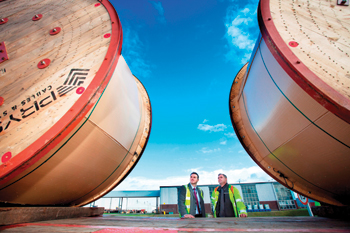
 Prysmian ... strong customer portfolio
Prysmian ... strong customer portfolio
PRYSMIAN is active in providing cables for diverse applications. It is principally engaged in developing, designing, manufacturing, supply and installation of wide range of cables for the energy and telecommunication sectors. The company’s strong liquidity, strong research and development (R&D) activity and broad customer base are its strength. Increasing receivables and geographical concentration are issues of concern. Nevertheless the company can leverage its opportunity through new contracts, acquisition. Intense competition, evolving technology environment can act as threat for the company, says GlobalData in a strengths, weaknesses, opportunities and threats (SWOT) analysis of the company.
STRENGTHS
Focused R&D activities: Prysmian’s focused R&D activities support its business growth and market position. The company’s R&D activities major thrust areas include cost reduction, process improvement, quality assurance, process control, and system development. It constantly focuses on developing new manufacturing methods and improving its existing manufacturing processes. Acquisition of Draka has significantly improved Prysmian’s R&D capabilities, particularly in fields of optical fibre, multimedia and special cables, elevator systems and cables for the oil industry. The company operates 17 R&D centres with the main R&D centre headquartered in Milan.
It has established strategic partnerships with major research centers and universities such as Polytechnic University in Milan, Trento’s Bruno Kessler Foundation in Italy, the University of Barcelona in Spain, the University of Sao Paulo in Brazil and the University of Delft in Holland. Prysmian employs more than 500 skilled professionals. At the end of 2013, the company had 5,731 patents and patent applications under its name, compared to 5,644 patents at the end of 2012. The company invested €68 million ($890 million) towards R&D activities in fiscal 2013 and €69 million ($81 million) in 2012. A strong focus on R&D activities will provide the company an edge over its competitors.
Strong and diverse customer portfolio: Prysmian has a diverse and strong customer base, which ensures strong top line performance. The company’s customer groups are spread across telecommunications and energy industry vertical, and others as well. Prysmian markets its products to high and extra-high voltage underground and submarine power transmission cables and systems users. It also provides industrial cables used in oil and gas, renewable energy, transport and mining, and telecommunication sectors. The company serves a large number of customers in several countries.
Its business model envisions developing proximity to its customers through high-value added services and propositions to enhance its service capabilities. Prysmian markets its products to original equipment manufacturers (OEMs) such as ABB, Aker, Petrobras, Peugeot-Citroen, Renault, Alstom, SNCF, Siemens and Leoni. Prysmian is associated with several projects for its utility customers, including China State Grid, Endesa, Enel, Iberdrola, Qatar General Electricity & Water Corporation, RWE, TenneT, Terna, Vattenfall, Dong Energy, and EON.
It is also associated with several telecom projects for British Telecom, France Telecom, Bharti, Telefonica, Telstra, Verizon, Telecom Italia and Vodafone. During the fiscal year ended December 2013, total revenue breakup in terms of customer segments comprised 31 per cent from trade and installers (T&I) segment, followed by utilities (26 per cent), industrial (24 per cent), telecom (17 per cent) and other (2 per cent). Such strong and diverse customer segments help Prysmian to minimise the risk from change in industry trends in a single industry sector.
Strategic initiatives: The company benefits from the initiatives it has taken to strengthen its operations through strategic acquisitions and expansion initiatives. These help the company to expand its operational capabilities and mitigate the risk of dependence on a single segment of operations.
The company is a leading provider of energy and telecom cables and systems. In May 2013, the company opened a new plant for the production of optical fibre cable in Slatina, Romania, which has become one of the centres of excellence in Europe for the optical communications cables industry. Prior to that, the company had acquired Global Marine Systems Energy, which undertakes installation of submarine power cables and systems for €53 million. The company can capitalise on GME’s expertise in offshore wind farm connections.
WEAKNESSES
Geographic concentration - EMEA Region: The company’s confined operations expose it to the risks associated with limited geographical operations, while also limiting its growth. The company classifies its operation into four geographical segments namely, Europe, Middle East, Africa (EMEA segment), North America, Central and South America, and Apac. For the fiscal year ended December 2013, EMEA accounted for 63 per cent of total sales followed by Apac with 15 per cent, North America with 14 per cent and South America with 9 per cent.The company has total 91 plants which are spread across 50 countries. But majority of its plants are located in EMEA. This concentration made the company more vulnerable than other competitors, which have greater geographical presence and diversified service offerings. It has to strategically increase its presence in other geographies to sustain its revenue growth and profitability.
OPPORTUNITIES
Global electricity outlook: Increasing population and industrialisation will lead to greater electricity demand. According to Energy Information Administration (EIA) 2011 report, world demand for electricity is expected to increase 2.3 per cent per year during the forecast period 2008 to 2035. To meet the rising demand, world net electricity generation is expected to increase 84 per cent during the forecast period 2008-2035, growing from 19.1 trillion kilowatt hours (kWh) in 2008 to 35.2 trillion kWh in 2035.
In 2008, non-OECD nations consumed around 47 per cent of the world’s total electricity, and their share of world consumption would grow during the projection period and by 2035, non-OECD nations would account for almost 60 per cent of world electricity use. According to EIA, total net electricity generation in non-OECD nations is expected to increase by around 3.3 per cent annually, which would be supported by 4 per cent annual increase in electricity generation in non-OECD Asia (including China and India) during the forecast period.
New Contracts: Prysmian’s ability to receive new contracts and its expansion activities provides growth opportunities. In May 2013, Prysmian secured a new contract worth more than $100 million for the supply and installation of submarine cables for a section of ExxonMobil’s existing offshore operations in the US. The scope of work involves the replacement of approximately 50 km of submarine power cables with increased capacity 40 kV EPR submarine cables designed for water depths of up to 450 metres. In March 2013, Prysmian secured a contract worth more than €50 million from TenneT.
In February 2013, Prysmian secured a contract worth more than €350 million from Alstom Grid. The project involves supply, installation and commissioning of High Voltage Direct Current (HVDC) 320 kV extruded submarine and land cable power cable connections with a rating of 900 MW and associated fibre optic cable system. Thus such contracts activities provide a stream of revenue over an extended period.
Positive outlook for cable market: The global cable and wire market is expected to reflect strong growth supported by positive movement in electricity demand and telecommunications market. Prysmian being a provider of industrial, high and low voltage power and system cables, and telecommunications cables could tap the opportunity provided in global cable market. The increase in demand for cables in gulf cooperation council (GCC) region is driven by the faster growth in gross fixed capital formation and investment in fixed assets in the region.
Demand for cable products is also on a rise due to higher demand supported by Europe, led by Germany, Denmark and Eastern Europe. Considering telecom market, there is a positive demand in North America supported by stimulus packages. Hence, Prysmian could expect a boost in its revenue driven by the positive outlook for the cable market with its wide and diversified customer base in conjunction with wide distribution network.
THREATS
Industry and regulatory changes: Changes in industry standards and regulatory requirements may adversely affect Prysmian’s business. As a manufacturer and distributor of wire and cable products for customers that operate in various industries, they are subject to a number of industry standard-setting authorities. The laws and regulations related safely and health which are affecting discharge of water, the generation and handling of waste and air emission. In addition, many of company’s products are subject to the requirements of federal, state and local or foreign regulatory authorities.
Evolving technology environment: Prysmian operates in energy and telecommunication equipment market, which experiences rapid and significant changes due to the introduction of innovative technologies and products. The company must continuously design new, and update existing products and services and invest in and develop new technologies in order to meet needs and requirements of the market. The company focuses in synthesising and conversion of raw materials into highly reliable, intelligent products.
Highly competitive market: The industries in which Prysmian operates are characterised by huge competition. The list of strong competitors includes General Cable Corporation, The Furukawa Electric Co, LS Cable & System, Nexans Hellas, Fujikura among others. Apart from the established players in the developed countries, players from emerging countries too are competing hard to gain maximum market share. Since many of its competitors have a longer operating history, greater brand recognition, established customer and supplier relationships and greater financial resources, it becomes difficult for the company to compete with them.










































































